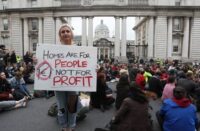On Tuesday 25th June, the LGBT committee of CPI’s Dublin branch organised a screening of the East German film, Coming Out (dir. Heiner Carow, 1989), with party members and members of the public in attendance. Coming Out was the last film produced in the GDR, by the production house DEFA, Deutsche Film-Aktiengesellschaft, which was state-owned.
It followed the release of a documentary about homosexuality in the Republik called Die andere Liebe (English: The Other Love, dir. Axel Otten and Helmut Kißling, 1988), which was commissioned by the German Hygiene Museum to convey official state acceptance of homosexuality.
Coming Out had its first screening on the day the Berlin Wall opened, 9th November 1989. The history of the GDR around queerness is a complicated one, but I would argue it’s miles better than what people in the West had before and after “Reunification”.
As almost everything in recent German history, this starts in the Weimar Republic and the Nazis. During the creation of the GDR, they inherited Paragraph 175a, which banned “unnatural desire” between men, with a clause protecting against the “seduction” of men and boys under the age of 21. The paragraph was not enforced from 1957 onwards, reverting back to the pre-Nazi law which mainly protected underage children and teens, and eventually homosexuality was decriminalised in 1968, and the law taken out of the books in 1988.
On 11th August 1987, the Supreme Court of the GDR struck down a conviction under Paragraph 151 on the basis that “homosexuality, just like heterosexuality, represents a variant of sexual behavior. Homosexual people do therefore not stand outside socialist society, and the civil rights are warranted to them exactly as to all other citizens.”
This is in contrast to West Germany, where Paragraph 175 was affirmed in the Constitutional Court and in active use until 1969. Stories of West German gays and lesbians being sent to prison by ex-Nazi judges are quite common, unfortunately, since the law was only abolished after the take over of East Germany, in 1994.
The GDR allowed for both men and women over the age of 18 to receive government-sponsored gender-affirming care as its healthcare system was free and fully nationalised. Transgender individuals were also allowed to marry other people and adopt children.
They lacked laws in recognising the new name and gender, but in contrast to the West, this was a whole step forward.
It is still incredibly difficult to receive care and to change your name and gender in Germany. It is a costly endeavour, which includes a €1,400 charge and at least one appearance in court. This is due to change but German politicians have been saying that since 2019.
Queer visibility in East Germany was an issue, but the LGBTQ+ advocacy groups did their utmost. Church societies helped them out a lot and the groups managed to change the stance of the government earlier than many other capitalist societies. One of the key figures, a trans woman called Charlotte von Mahldorf, is an extra in Coming Out.
The Kulturbund then allowed the Magnus Hirschfeld Arbeitskreis (Study Group) to organise, under the guise of promoting scientific endeavours in sexuality. State organisations also began training staff for issues with sexual identity. The FDJ, after 1985, began discussing homosexuality and bisexuality and creating events for the community.
The film was of great significance for the LGBT community in East Germany. The main characters, Phillip and Matthias, are played by openly gay actors, and the areas where most of the filming took place, were common meeting points for gay men in East Germany such as the Märchenbrunnen in Volkspark Friedrichshain and bars such as Schoppenstube in Prenzlauer Berg and Zum Burgfrieden. The apartments in the film were some of the producers’ actual apartments.
This film’s aim was to further show the public that queer people exist and that further conversation had to take place so they would not feel alone and ostracised, which a lot of queer people still felt. It was a step towards normalisation and embracing of queer culture in its many forms.
The film is a moving piece of LGBTQ+ history that many people don’t know about and barely gets any mention in modern Germany, as it shows a positive outlook on the society at the time. The fact that it is state-produced and was approved of by the State at the time, is worth emphasising as well, as it goes against the propaganda the Federal German state now loves to fill our heads with.
It’s a stark reminder that we still have much work to do.






